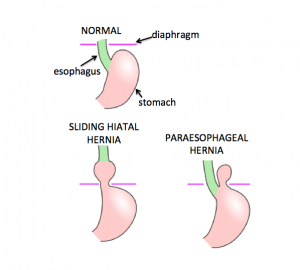
Hiatal Hernia – What You Need to Know
I get asked about hiatal hernias a lot – what are they, can they be fixed, and most importantly, are they the cause of my symptoms.
Chances are, if you’ve been told you have a hiatal hernia, it’s because you underwent some sore of upper-GI investigation, like an endoscopy or barium swallow, as part of a work-up for symptoms. There’s no way a hiatal hernia can be diagnosed just be looking at you or through a regular physical exam. So it’s no surprise that most people who know they have a hiatal hernia also tend to have upper GI symptoms, like heartburn, pain or trouble swallowing. This can sometimes lead people to conclude that the hiatal hernia must be responsible for the symptoms – because everyone else on the online forum with a hiatal hernia also has symptoms.
It’s important to remember that hiatal hernias are very common, and most often are totally asymptomatic. Here’s what you need to know about hiatal hernias.
What is a hiatal hernia?
The diaphragm is layer of muscles, that acts as a divider between the chest and the abdomen (like the floor of the chest cavity and the ceiling of the abdominal cavity). The esophagus is the swallowing tube that runs from your mouth to you stomach, meaning it passes through the chest to end up in the abdomen. In order to allow the esophagus through, there’s an opening in the diaphragm, known as the hiatus. Think of it like those pole firefighters slide down (that’s your esophagus), and the hole in the floor of the upstairs to allow the pole to extend to the floor below. Typically, the stomach sits right below the diaphragm (in the “downstairs” abdominal cavity). In people with a hiatal hernia, a part of the stomach pushed up through the hole in the diaphragm. Most of the time, this is because unlike the firefighter’s pole, the esophagus isn’t fixed, and can slide up and down a little bit, bringing the stomach along for the ride. This is called a sliding hiatal hernia. In rare cases, the top of the stomach can push up through the hole in the diaphragm, along side the esophagus. This is a more serious condition called a paraesophageal hernia. Since paraesophageal hernias are pretty uncommon, for the purposes of this discussion, when I refer to a hiatal hernia, I mean a sliding hernia.
What are some symptoms of a hiatal hernia?
The vast majority of the time, a hiatal hernia causes absolutely no symptoms at all. Some people have hypothesized that a hiatal hernia can worsen symptoms of acid-reflux, because when the top of the stomach slides up above the diaphragm, the diaphragm “pinches” that bubble of tissue, making it hard for the stomach acid to move back down to the lower parts of the stomach, and instead causes them to reflux upwards into the esophagus. Symptoms of acid reflux include heartburn, pain in the chest or stomach, acidic taste or pain in the throat, or trouble swallowing. (But these symptoms are general and can be caused by any number of things – so always discuss symptoms like these with your doctor!).
How is a hiatal hernia treated?
Most of the time, hiatal hernias do not cause symptoms and do not require treatment. If it’s thought that you have symptoms of acid reflux, your doctor may suggest a combination of dietary and lifestyle changes, and/or medications – the same things doctors would suggest whether or not you have a hiatal hernia. To learn more, read about heartburn here.
If you have an exceptionally large hiatal hernia that’s causing a lot of trouble, your doctor may recommend that it be corrected. The only way to do this is with an operation to pull the stomach down and prevent it from going back up.
So the long and the short of it: unless your doctor has told you otherwise, your hiatal hernia is most likely just something that was found by accident, and not something you need to treat.








